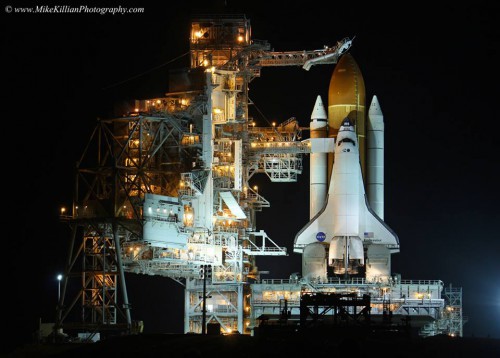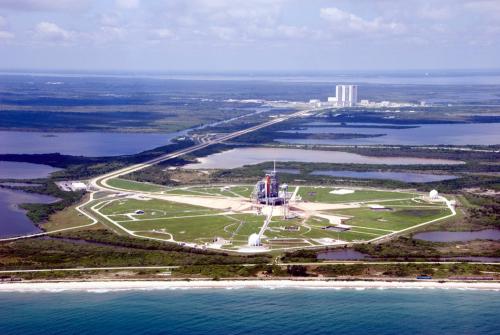
There’s only one place on Earth where humans left to touch the face of another world, and this week Space Exploration Technologies (SpaceX) finalized an agreement with NASA to put that place (launch pad 39A) to use again for at least the next couple decades.
The deal, signed into agreement earlier this week, gives the Hawthorne, Calif.-based company control of the seaside launch pad at NASA’s Kennedy Space Center in Florida for the next 20 years, with the bill for operations and maintenance of the launch facility also being their responsibility. The agreement effectively puts LC-39A back to work while freeing NASA from paying to maintain the launch facility, which has been withering away from sea salt, weather, and lack of maintenance since the last space shuttle launched from there nearly three years ago.

“It’s exciting that this storied NASA launch pad is opening a new chapter for space exploration and the commercial aerospace industry,” said NASA Administrator Charles Bolden. “While SpaceX will use pad 39A at Kennedy, about a mile away on pad 39B, we’re preparing for our deep space missions to an asteroid and eventually Mars. The parallel pads at Kennedy perfectly exemplify NASA’s parallel path for human spaceflight exploration — U.S. commercial companies providing access to low-Earth orbit and NASA deep space exploration missions at the same time.”
The launch site, which is on the U.S. National Register of Historic Places, was used to launch Americans to the Moon atop the mighty Saturn-V rocket (with the exception of Apollo 10, which launched from pad 39B). All the Moon-landing missions ever made by human beings, Apollo flights 11-17, took place from 39A, as did the first—and last—space shuttle missions. A total of 80 out of 135 shuttle missions launched off 39A, including missions to construct the International Space Station and service the Hubble Space Telescope, but with the retirement of the STS program in 2011 NASA no longer had any use for 39A. Instead, the space agency is preparing nearby pad 39B to launch the Space Launch System (SLS) and Orion spacecraft on crewed deep-space missions.
As reported by AmericaSpace in early 2013, abandoning pad 39A was never an option for NASA, despite the fact that the space agency never had any intention of using pad 39A again after the last shuttle flight. The reason is, of course, money; it would cost a lot more to abandon 39A rather than lease it to a commercial partner because 39A is a historic site. If NASA ever did permanently cease use of the location, the agency would have to by law restore 39A to how it appeared during the Apollo era.
“We remain committed to right-sizing our portfolio by reducing the number of facilities that are underused, duplicative, or not required to support the Space Launch System and Orion,” said Kennedy Center Director and three-time shuttle veteran Bob Cabana in 2013. “Launch Complex 39A is not required to support our asteroid retrieval mission or our eventual missions to Mars, but it’s in the agency’s and our nation’s best interest in meeting our commitment and direction to enable commercial space operations and allow the aerospace industry to operate and maintain the pad and related facilities.”
SpaceX will begin transforming 39A to support launching their fleet of Falcon rockets later this year, and they intend on launching their mammoth Falcon-Heavy rocket first, as soon as 2015.

“We’ve had architects in our launch site engineering team working for many months on the sidelines,” said SpaceX President and COO Gwynne Shotwell. “We will launch the Falcon Heavy from this pad early next year and carry on with additional commercial launches next year. If we are granted the pleasure of moving forward in the commercial crew program, we would launch the Dragon capsule with crew here at 39A as well. As the world’s fastest growing launch services provider, SpaceX will maximize the use of pad 39A both to the benefit of the commercial launch industry as well as the American taxpayer.”
The terms of the lease agreement require SpaceX to preserve some of the pad’s historic items, such as the “rubber room” beneath the pad, but for the most part SpaceX will be modifying 39A as needed to support their operations, such as raising the pad’s Fixed Service Structure and constructing a hangar to support horizontal integration, which is how the company currently prepares for launch at nearby Cape Canaveral AFS Space Launch Complex-40. However, if the company ever hopes to compete with United Launch Alliance for military launch contracts, then they will be required to also have vertical integration capability, as the U.S. Air Force will not consider horizontal integration for their national security assets. SpaceX has already received $4.2 million in funds from the USAF for early integration studies, and the USAF has even stated the SpaceX Falcon-9 v1.1 rocket should be certified in time to compete for the FY17 launches.
The lease agreement to put 39A back to work is only the latest milestone in a decade-long overhaul to modernize Kennedy Space Center into a multi-user space port. Gone are the days where only NASA launches from KSC. Boeing is currently leasing the former space shuttle Orbiter Processing Facility Bay-3 to build their CST-100 spacecraft, Lockheed and NASA are working together to construct the Orion spacecraft in the Operations and Checkout Building, and Sierra Nevada Corporation (SNC) will be using the same building to support pre-flight and post-flight processing operations for their Dream Chaser spacecraft. SNC will also put the Shuttle Landing Facility back to work as the preferred landing site for the Dream Chaser. Additionally, NASA is modifying the iconic 525-foot-tall Vehicle Assembly Building to support operations to launch both their SLS/Orion as well as commercial launch vehicles—even the gigantic Crawlers are being modified to support transporting the SLS and other commercial launch vehicles to and from pads 39A and 39B (NASA has stated they will permit use of pad 39B for other commercial companies when it’s not needed for SLS).

“Kennedy Space Center is excited to welcome SpaceX to our growing list of partners,” said Cabana. “As we continue to reconfigure and repurpose these tremendous facilities, it is gratifying to see our plan for a multi-user spaceport shared by government and commercial partners coming to fruition.”
NASA made the decision to lease 39A to SpaceX late last year after the U.S. Government Accountability Office (GAO) denied a protest filed against the Agency by Blue Origin LLC, which cited the competitive process NASA was using to try to secure a potential commercial partner for 39A favored one proposed use of the historic launch facility over others.
SpaceX is currently preparing to launch their unmanned Dragon capsule atop a Falcon-9 rocket from nearby Cape Canaveral AFS this Friday on the company’s third contracted ISS resupply mission under a $1.6 billion contract with NASA. The AmericaSpace team is on-site at KSC and Cape Canaveral AFS and will have full coverage of the launch when it occurs.
Want to keep up-to-date with all things space? Be sure to “Like” AmericaSpace on Facebook and follow us on Twitter: @AmericaSpace



